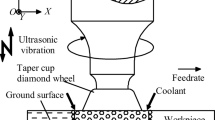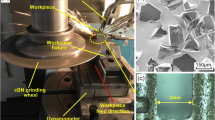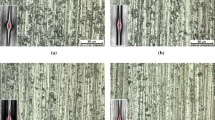Abstract
Cubic Boron Nitride (cBN), a kind of super abrasive material with excellent properties, is widely applied into the manufacturing of high end grinding tools especially for high speed machining fields. During the actual grinding process, abrasive failure phenomena take place, which affects the grinding tool performance, and then the final machining quality. Considering the high speed applicability of cBN grinding tools, it is of significance to investigate the failure mechanism and grinding performance of cBN abrasives at different grinding speeds, in particular under high speed condition. Therefore, this paper carries out an investigation of cBN abrasive failure behavior taking grinding speed sensitivity into consideration. Given that the random and diversity of multi-abrasives distributed upon grinding tools contributes to the complexity of the study, single cBN abrasive cutting experiments are conducted under four grinding speed levels of 40, 60, 80 and 100 m/s, respectively. When all experiments are completed, abrasive failure patterns can be identified through observation on the morphology of ground cBN abrasives bonded on cutting inserts using Scanning Electron Microscope (SEM). Based on the analysis of experimental results, it is shown that for the cBN abrasives studied in this paper, abrasive breakage occurs at low grinding speed, but as speed increases, cBN abrasives tend to get worn. The change of grinding forces, as well as roughness Ry values, can show the detailed failure behavior of tested cBN abrasives with time dependent features. In addition, G ratio rises with the increase of grinding speed, which demonstrates the high productivity potential of cBN high speed grinding. Finally, an in-depth analysis concerning on cBN material’s crystal characteristics and energy threshold (binding energy) is discussed, which provides an intrinsic explanation on the influence of grinding speed upon cBN abrasive failure mechanism.














Similar content being viewed by others
References
Jackson MJ, Davis CJ, Hitchiner MP, Mills B (2001) High-speed grinding with CBN grinding wheels - applications and future technology[J]. J Mater Process Technol 110:78–88
Kassen G (1969) Beschreibung der elementaren kinematik des schleifvorgangs, Doctoral Thesis, Technische Hochschulle Aachen, Germany
Werner G (1972) Kinematik und mechanik des schleifprozesses, Doctoral Thesis, Technische Hochschulle Aachen, Germany
Liu Y, He D, Lei L, Chen X, Xu C, Wang P, Liu F, Zhang Y, Hu Y (2015) High pressure infiltration sintering of cBN-Si composites[J]. Int J Refract Met Hard Mater 50:247–252
Sugihara T, Enomoto T (2015) High speed machining of Inconel 718 focusing on tool surface topography of CBN Tool[J]. Proc Manuf 1:675–682
Cai R, Rowe WB (2004) Assessment of vitrified CBN wheels for precision grinding[J]. Int J Mach Tool Manuf 44:1391–1402
Ding W, Zhu Y, Zhang L, Xu J, Fu Y, Liu W, Yang C (2015) Stress characteristics and fracture wear of brazed CBN abrasives in monolayer grinding wheels[J]. Wear 332–333:800–809
Linke B, Klocke F (2010) Temperatures and wear mechanisms in dressing of vitrified bonded grinding wheels[J]. Int J Mach Tools Manuf 50:552–558
Buhl S, Leinenbach C, Spolenak R, Wegener K (2013) Failure mechanisms and cutting characteristics of brazed single diamond abrasives[J]. Int J Adv Manuf Technol 66:775–786
Fujimoto M, Ichida Y (2008) Micro fracture behavior of cutting edges in grinding using single crystal cBN abrasives[J]. Diamond Relat Mater 17:1759–1763
Ichida Y (2008) Mechanical properties and grinding performance of ultrafine-crystalline cBN abrasive abrasives[J]. Diamond Relat Mater 17:1791–1795
Singh R (2016) Applied welding engineering (Second Edition): processes, codes, and standards, chapter 7 - cast iron. Butterworth-Heinemann
Panneerselvam S, Martis CJ, Putatunda SK, Boileau JM (2015) An investigation on the stability of austenite in Austempered Ductile Cast Iron (ADI)[J]. Mater Sci Eng A 626:237–246
Cardoso PHS, Israel CL, Strohaecker TR (2014) Abrasive wear in Austempered ductile irons: a comparison with white cast irons[J]. 313: 29–33
Xiao B, Fan Z, Jiang W, Liu X, Long W, Hu Q (2014) Microstructure and mechanical properties of ductile cast iron in lost foam casting with vibration[J]. Int J Iron Steel Res 21:1049–1054
Liang Z, Wang X, Wu Y, Xie L, Jiao L, Zhao W (2013) Experimental study on brittle–ductile transition in elliptical ultrasonic assisted grinding (EUAG) of monocrystal sapphire using single diamond abrasive grain[J]. Int J Mach Tools Manuf 71:41–51
Zhi G, Li X, Bi W, Tang J, Rong Y (2015) The measurement and analysis of micro bonding force for electroplated CBN grinding wheels based on response surface methodology[J]. Eng Fail Anal 57:377–388
Xie J, Wei F, Zheng JH, Tamaki J, Kubo A (2011) 3D laser investigation on micron-scale grain protrusion topography of truncated diamond grinding wheel for precision grinding performance[J]. Int J Mach Tools Manuf 51:411–419
Malkin S (1989) Grinding technology: theory and applications of machining with abrasives, Society of Manufacturing Engineers
Shammas J, Sun T, Koeck FAM, Rezikyan A, Nemanich RJ (2015) In situ photoelectron spectroscopic characterization of c-BN films deposited via plasma enhanced chemical vapor deposition employing fluorine chemistry[J]. Diamond Relat Mater 56:13–22
Sumiya H, Harano K, Ishida Y (2014) Mechanical properties of nano-polycrystalline cBN synthesized by direct conversion sintering under HPHT[J]. Diamond Relat Mater 41:14–19
Eko A, Fukunaga O, Ohtake N (2013) The microstructure of cBN-metal composites synthesized from hBN with metallic solvents[J]. Int J Refract Met Hard Mater 41:73–77
Lawn BR (1993) Fracture of brittle solids, Second Edition. Cambridge University Press
Popov VL (2010) Contact mechanics and friction: physical principles and applications. Springer
Zhang T, Song W, Kou H, Li J (2016) Surface valence transformation during thermal activation and hydrogenation thermodynamics of Mg-Ni-Y melt-spun ribbons[J]. Appl Surf Sci 371:35–43
Kleiv RA, Thornhill M (2016) The effect of mechanical activation in the production of olivine surface area[J]. Miner Eng 89:19–23
Shiau L-D, Wang H-P (2016) Simultaneous determination of interfacial energy and growth activation energy from induction time measurements[J]. J Cryst Growth 442:47–51
Peguiron A, Moras G, Walter M, Uetsuka H, Pastewka L, Moseler M (2016) Activation and mechanochemical breaking of C-C bonds initiate wear of diamond (110) surfaces in contact with silica[J]. Carbon 98:474–483
Marder M (2004) Effects of atoms on brittle fracture[J]. Int J Fract 130:517–555
Kermode JR, Albaret T, Sherman D, Bernstein N, Gumbsch P, Payne MC, Csanyi G, De Vita A (2008) Low-speed fracture instabilities in a brittle crystal[J]. Nat Lett 455:1224–1228
Acknowledgments
The research is supported by National Science Foundation of China (NSFC: E51305229), NSAF: U1430116, and Tsinghua University Initiative Scientific Research Program. The authors would also appreciate the support by Saint-Gobain Research (Shanghai) Co., Ltd.
Author information
Authors and Affiliations
Corresponding author
Rights and permissions
About this article
Cite this article
Zhi, G., Li, X., Luo, A. et al. An Experimental Investigation on Response of cBN Super Abrasive’s Grinding Performance and Failure Characteristics to the Grinding Speed. Exp Tech 41, 117–130 (2017). https://doi.org/10.1007/s40799-016-0159-9
Received:
Accepted:
Published:
Issue Date:
DOI: https://doi.org/10.1007/s40799-016-0159-9




